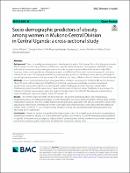| dc.contributor.author | Justine, Athieno | |
| dc.contributor.author | Georgina, Seera | |
| dc.contributor.author | Faith, Muyonga Mayanja Namayengo | |
| dc.contributor.author | Joweria, Nambooze Galabuzi | |
| dc.contributor.author | Mariam, Namasaba | |
| dc.date.accessioned | 2024-04-22T07:24:11Z | |
| dc.date.available | 2024-04-22T07:24:11Z | |
| dc.date.issued | 2023-11 | |
| dc.identifier.citation | Athieno, J., Seera, G., Mayanja Namayengo, F. M., Galabuzi, J. N., & Namasaba, M. (2023). Socio-demographic predictors of obesity among women in Mukono Central Division in Central Uganda: a cross-sectional study. BMC Women's Health, 23(1), 571. | en_US |
| dc.identifier.uri | https://doi.org/10.1186/s12905-023-02679-4 | |
| dc.identifier.uri | https://hdl.handle.net/20.500.12504/1670 | |
| dc.description.abstract | Abstract
Background
There is a steadily increasing trend in obesity globally and in Sub-Saharan Africa that disproportionately
affects women in most places. This is not different in Uganda, where the Uganda Demographic and Health Survey
indicated an increase in obesity among women of reproductive age as measured by the body mass index (BMI).
However, studies on the predictors of obesity in women are still limited. Particularly, studies using specific indicators
of body fat are scant. This study explored the socio-demographic predictors of obesity as indicated by total body fat
percentage among women in the age range of 18 to 69 years old living in Mukono Central Division in Central Uganda.
Methods
A cross sectional study design using quantitative methods was employed. A total of 384 women between
18 and 69 years old from Mukono Central Division in Central Uganda were randomly recruited. A structured
questionnaire was used to collect socio-demographic data including age, level of education, marital status,
childbearing status, household expenditure, household size and employment status. Total body fat percentage, the
indicator for obesity was measured using the body composition meter from TANITA. The data was analyzed using
multinomial logistic regression analysis using SPSS version 20.
Results
155 women, nearly two fifths (40.4% CI 95% 38.4–42.4) were classified as obese. Age, marital status,
childbearing status, and employment status were the factors that were associated with obesity among these women.
Employment status was the only variable that remained significantly associated with obesity among the women after
adjusting for other factors. Unemployed women were nearly two times more likely to be obese than the employed
women (AOR 1.9; 95% CI 1.1–3.1). The prevalence of obesity among the unemployed and employed women was
48.2% and 34.4% respectively.
Conclusions
Obesity in women was predicted by employment status. An in-depth study on factors that predispose
unemployed women to obesity, will be instrumental in guiding interventions to curb the emerging obesity epidemic
in Uganda. In the same vein, strategies to reduce levels of unemployment among women living in urban Uganda are
essential for protecting public health from the dimension of reducing obesity levels. | en_US |
| dc.language.iso | en | en_US |
| dc.publisher | BMC Women's Health | en_US |
| dc.subject | Obesity | en_US |
| dc.subject | Total body fat percentage (TBF%) | en_US |
| dc.subject | Socio-demographic predictors | en_US |
| dc.subject | Working status | en_US |
| dc.subject | Employment status | en_US |
| dc.subject | Unemployment and Informal employment | en_US |
| dc.subject | Women and Food security | en_US |
| dc.title | Socio-demographic predictors of obesity among women in Mukono Central Division in Central Uganda: a cross-sectional study | en_US |
| dc.type | Article | en_US |

